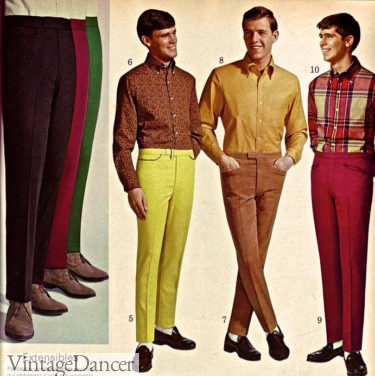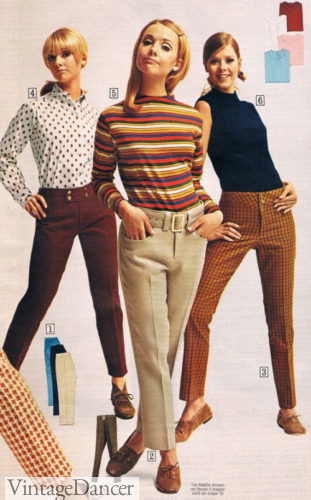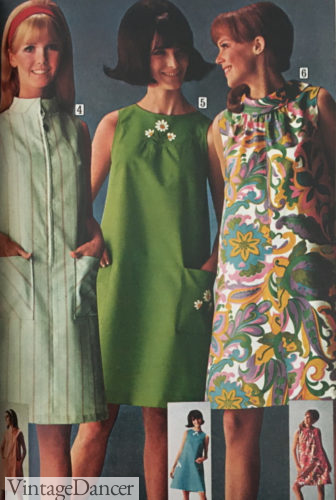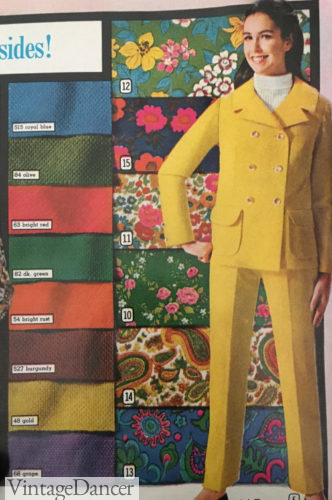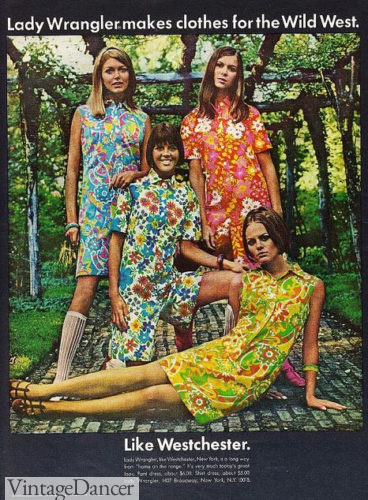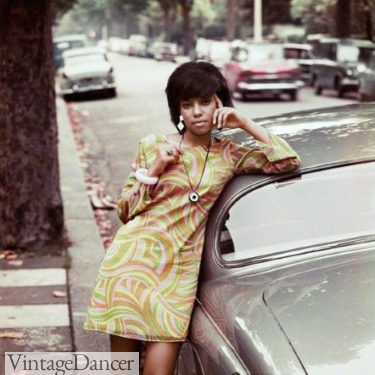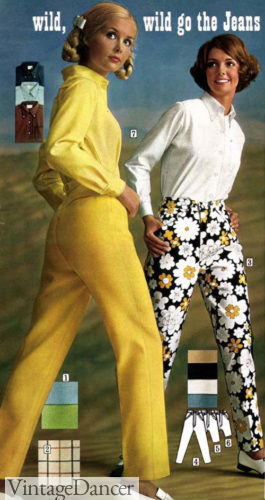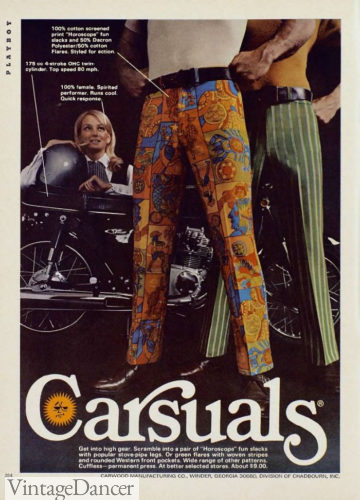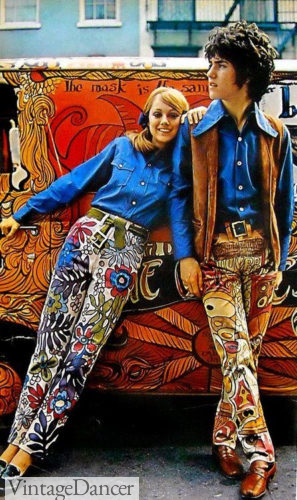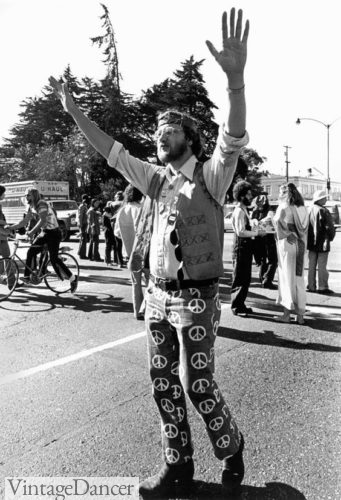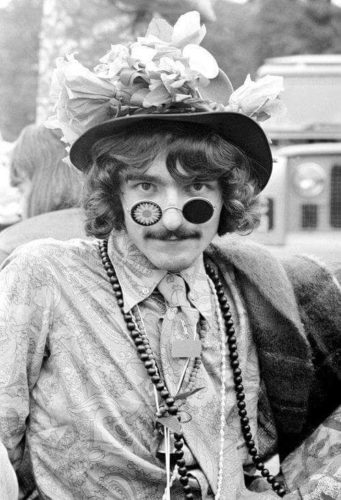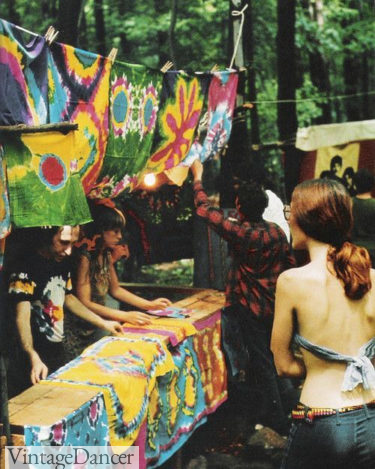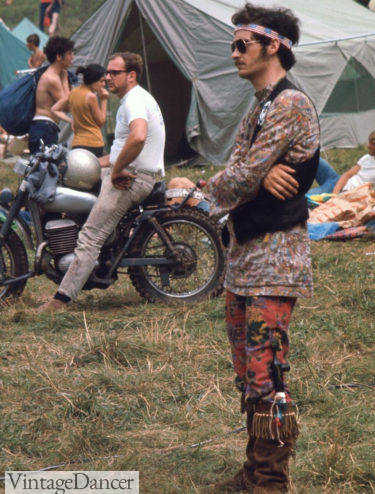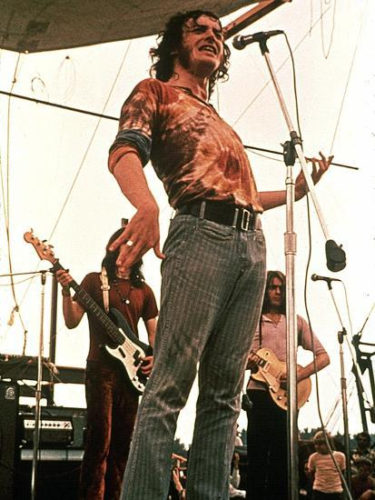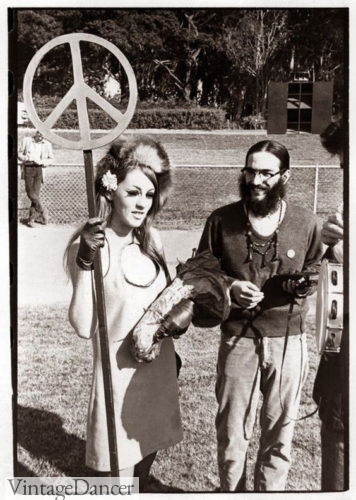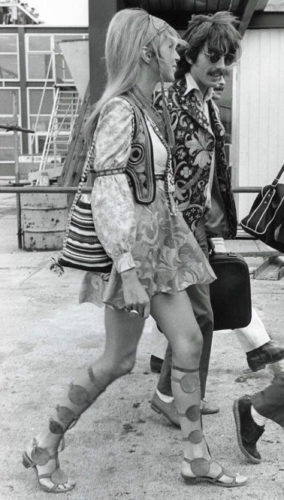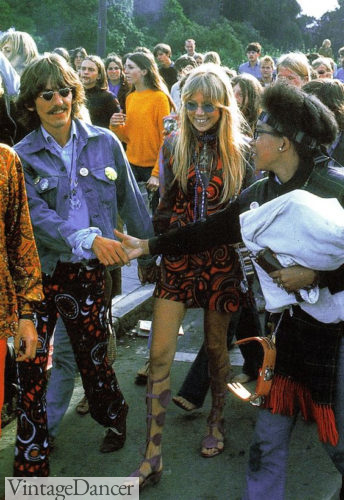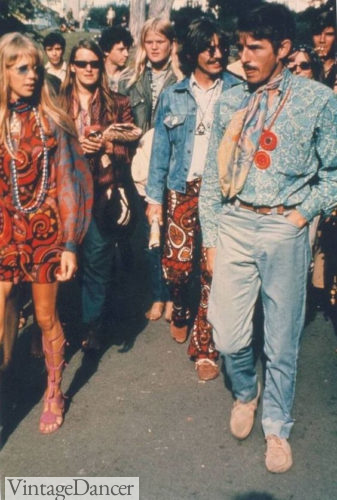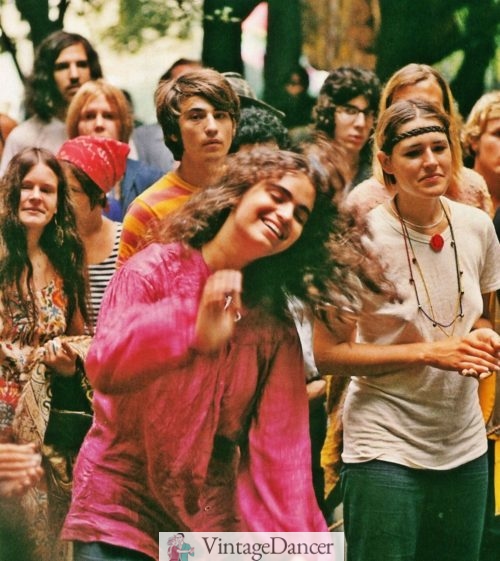
A group of hippie women at Woodstock 1969
’60s hippies were a single piece in a tumultuous decade of social change. Rapidly advancing technology, musical revolution, major conspiracy theories, and booming Civil Rights movements all converged in the 1960s, and the effect made waves. That said, the ‘60s weren’t quite “The Sixties” as they’re remembered until about halfway through the decade.
After nearly twenty years of postwar prosperity, JFK’s assassination in 1963 and escalation in the Vietnam War set the stage for unrest among the American people. Perspectives across the nation shifted to ones of vulnerability, loss of innocence, and even mistrust. From this came a surge of protests, skepticism, and political activism from the younger generation in particular. With a growing influence and a wild sense of self expression, these students developed into the iconic counterculture of the 1960s — hippies. Their anti-fashion silhouettes, Flower Power prints, psychedelic colors, peace signs, long hair, and flared pants were radical fashion statements that took America by force in the mid 1960s… until they became the norm in the mid ’70s, that is.
Why did that happen? How did that happen so quickly? Believe it or not, it had a lot to do with clothes. This article details a brief history of ’60s hippies, while the second half delves into the development and influence of ’60s hippie fashion. If you’d like to skip to the fashion part of the article, scroll down or click here.
Who were 1960s Hippies?
If you had asked a businessman in the late 1960s, he wouldn’t have painted a pretty picture. Hippies at the time were typically seen as dirty, drug-addled college drop-outs who didn’t know how the world worked. Their penchant for disruption put them at odds with a nation still stuck in the white picket fence suburbia of 1950s culture. While their style and ideals would grow increasingly more popular in the late 1960s, the “hippie” label always carried with it a rather dirty reputation. From the press and the public alike came accusations of drug abuse, corruption of youth, political extremism, conspiracy, and an association with cult leader Charles Manson in the later years.
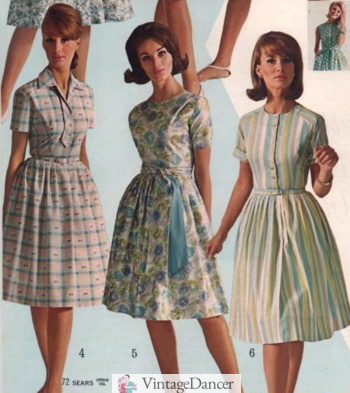
1965 – The dutiful housewife look was still the predominant style for women in the mid 1960s.
The reality wasn’t quite so stark. Hippies of the 1960s were free-spirited, predominantly white upper-middle class students from liberal colleges, notably Berkeley and San Francisco State University. Their roots and inspiration came from the ’50s Beat Generation and its anti-establishment, anti-materialism, and pro-obscenity lines of thought. It was hippies themselves who popularized the use of psychedelics, created experimental music as self-expression, and forged a more upbeat philosophy on the richness of life, experience, and harmony. Hippie hedonism and in-the-moment values could be summarized by one of their own key phrases: “if you like it, do it.”
Looking back at them today, hippies are remembered mostly as a group of peace advocates. Their political leanings are credited with defining the “New Left” as well as modern environmentalism, and you have them to thank for the popularity of organic foods, tie dye, yoga, light-wash jeans, bohemian fashion, and the omnipresence of that “live and let live” attitude. Even over fifty years later, ’60s hippies hold enough social influence and appeal to generate neo-hippie communities both in person, in fashion, and online.
History of the 60s Hippie Movement
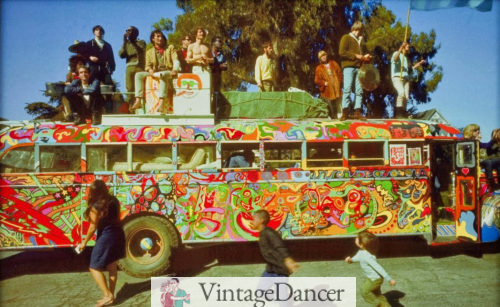
1964 – The Merry Pranksters and their bus, “Furthur”
In 1964, author Ken Kesey and his band of Merry Pranksters took a painted-up school bus from California to New York in an acid-fueled, psychedelic road trip. 1965 marked the word “Hippie” first appearing in a newspaper, referencing the “hipster” community of San Francisco’s Haight-Ashbury district. By 1967 there were countless names (and insults) for this emerging group of youth – hippy, drug freak, drop-out, flower child, Vietnik, Yippie, treehugger, and countless others. There was also just as much division among them.
Very little initially unified 60s hippies as a subculture, much less as a political group. Perspectives were almost universally progressive, though not always political. Instead, they mostly revolved around sexual liberation, drug use, and the importance of “breaking out of it” — or expanding horizons. The divide between hippie activists and the politically detached hippies put both protests and “why bother?” anti-protests from various groups under the hippie name. This and constant infighting only added to the disorganization of hippies as a whole.
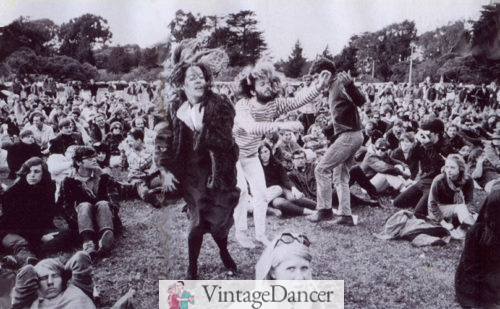
Students at the Human Be-In of 1967
The foundation of a more standard hippie identity, as well as their recognition as a 1960s counterculture, began with the Human Be-In of 1967. Students from various campus groups came together and unified under the mutual rejection of the Vietnam War, government authority, and reigning middle class values. Further, they voiced support of artistic expression, experimental drugs, spiritual transcendence, harmony with nature, and communal brotherhood. Many early hippies rejected this new identity and the way things were turning — that they were too political, not political enough, too involved in drugs, and countless other complaints came from the fringes. But with this new cohesive role, the hippie influence took off. Resistance was silenced by the sheer numbers of new hippies flooding San Francisco to join the movement.
More be-ins, festivals, and protests were organized in what grew to be known as the ‘67 Summer of Love. By the end of the year, there were so many hippies that the Haight-Ashbury neighborhood was beyond capacity and many were left sleeping on the streets. By the end of the decade, hippies had become a cultural commodity.
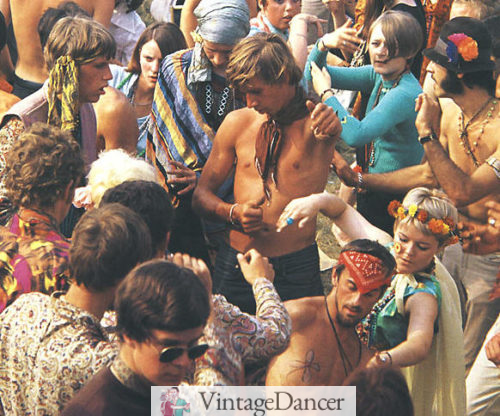
Colorful and absurd, a group of hippies groove together in 1967.
While there is no official date marking the end of the hippie movement, there were many factors contributing to its quick decline in the early ’70s. The Woodstock Music Festival of 1969 was such a massive success that it showed the profitability of the music industry — the event actually lost money, but its popularity fueled others to produce more concerts with better planning. Music festivals, a major aspect of hippie culture, began powering themselves with cash instead of good vibes. In the same window of time, major Hippie musicians such as Janis Joplin and Jimi Hendrix died of drug overdose. Drug addiction and the consequences of drug use among hippies became impossible to ignore, communes dissolved, and the movement itself once again lost its footing.
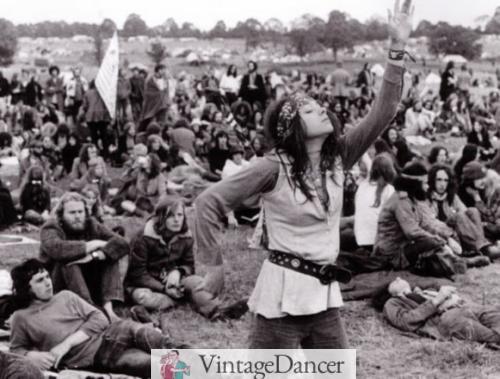
A hippie woman dances freely at the Woodstock Music Festival (1969)
Perhaps the biggest contributor to the end of the hippies in the ’70s, however, was its own overwhelming success. By the early-mid 1970s, America had changed. Opposition to the Vietnam War was the majority perspective, Civil Rights movements had made massive advancements, and that “disruptive” hippie anti-fashion became, well, fashionable. With the Fall of Saigon in 1975, “flower power” became pop culture, and reacting to that pop culture came the new counterculture – punks and metalheads.
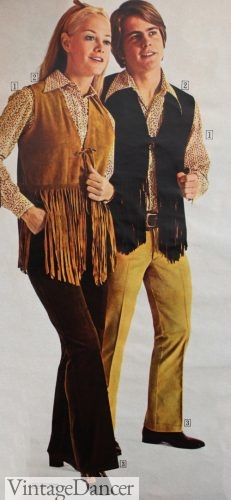
1970 hippie chic – fringe vests and flares sold in Sears stores. Hello mainstream!
Hippie Fashion
1960s hippie fashion wasn’t always flares and tie dye shirts. As a matter of fact, the foundation of what hippies wore, particularly in the beginning, was similar to Beatnik or early Mod fashion. Color palettes were toned down, patterns (if present) were basic, and outfits were overall simple. Workshirts, drainpipe trousers, mohair sweaters, tee shirts, and canvas shoes made up a majority of the early hippie wardrobe for both men and women.
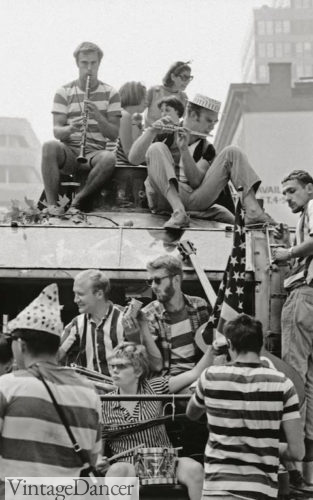
The Merry Pranksters “tootling” in 1964. Simpler outfits were paired with absurd hats, unusual accessories, or excessive amounts of body paint.
These early hippie outfits were made distinct with an “accent” piece such as a garish Western shirt, a non-matching hat, or bright rubber rain boots. Day-Glo paint was also used to paint bodies, faces, hands, and clothes.
- 1966 mens mod drainpipe pants and button down shirts with loafers
- 1967 narrow leg “hip hugger” pants with blouses or mock neck shirt
Go here for more about 60s mod fashion for women that you can adapt into early 60s hippie outfits. Look here for men’s 60s outfit ideas.
Seeking the role of anti-fashion, this “cleaner” hippie look would evolve just as quickly as it took for people to adjust to it. In the five years between 1964 and 1969, hippie fashion did a full 180. Pants became flared and baggy, colors grew saturated, and psychedelic patterns such as paisley and mandalas were inescapable. 1968 was the height of flower power and trippy hippie fashion, and it began seeping into the mainstream.
- 1968 – daisy flowers on a green dress and a bright swirly paisley print.
- Emerging trippy prints and bright colors in 1967
- 1968 – Even Wrangler Made Trippy Dresses
- Woman with swirled paisley dress
Jeans could be bleached, studded, adorned with patches, torn up, and then painted over. As soon as “ridiculous” was established, it would become popular, then it was on to “even more ridiculous” to produce the same effect. Dedicated hippies who sought to look “way out” fought hard to stay ahead of an ever-rising standard that they themselves were setting.
- Flower power print jeans
- Flower power men’s pants
- 60s decorated pants
- Peace sign jeans
In a time of disruption, the hippies were an endless source of inspiration for new trends, silhouettes, and colors for fashion designers. Their rebelliousness and stylistic emphasis on drawing attention would pave the way for a decade of groovy 1970s individuality, loudness, and casualwear.
Influences and Motifs of 1960s Hippie Fashion
The evolution of hippie fashion was sculpted by the passions, perspectives, and backgrounds found within the movement. While it would be impossible to name everything to ever influence their clothing style, the primary ones were as follows:
Asia. Like beatniks, hippies took heavy inspiration from the East – particularly its religion and iconography. Silhouettes went loose and flowy with tunics, kaftans, kimono shawls, and light crisp fabric clothes. Rich ethnic prints were popular for any article of clothing, and Eastern dyeing techniques were adapted to make the iconic hippie tie dye. Dharmic symbols, Buddha, and the Taoist yin-yang were used often in fabric prints, art, stencils, and jewelry. In 1968, The Beatles took a trip to India that would make the Asian influence even more popular, both with hippies and in mainstream fashion.
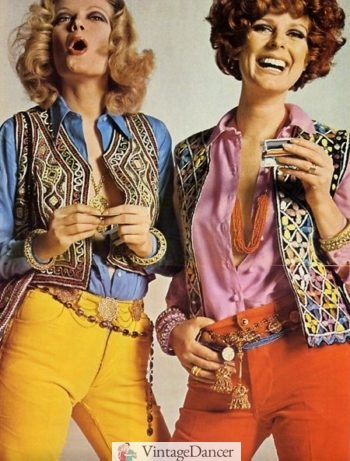
Indian print vests ad a touch of hippie style
Psychedelia. Hippie culture was heavily immersed in psychedelic substances such as LSD and psilocybin (magic mushrooms). From the widespread use of these psychedelics came an appreciation for “trippy” art, which in turn popularized bright colors and kaleidoscopic, far-out patterns. Clothes were also lightened for both comfort and ease of functioning while high.
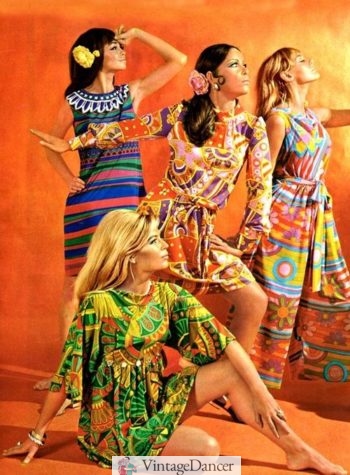
(1968) Short dresses with bright patterns, a fitted bodice, and movement at the hem took off in the fashion industry.
Mother Nature. Prairie dresses and flower power were key to making a statement in both anti-war and environmental protesting. Flowers, feathers, hemp rope, leather, linen, straw, and recycled fabrics gave even more earthy and natural aspects to wardrobes as hippies began living closer to nature. This eco movement came from both environmentalism and a psychedelic feeling of oneness with the world.

Flower children in homemade peasantry
Militaria and Bikers. Many Vietnam veterans who returned home joined the hippie movement, introducing field jackets, vests, utility coveralls, and patches into hippie style. Bikers, a fellow counterculture group with a heavy veteran presence, also wore practical clothes and introduced rugged biker boots, leather goods, vests, and jackets. Military surplus stores were cheap, accessible, and the best source for clothes endorsed by both groups. The iconic hippie bell bottom jeans began as Navy bell-bottom trousers sold at surplus stores.
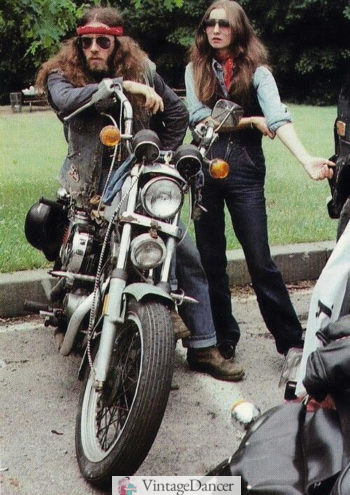
1970s biker hippies
Western Clothes and Workwear. Chambray shirts, bolo ties, henleys, mechanic’s trousers, and Western shirts were accessible, baggy, and durable. Westernwear with more Native American style such as fringe jackets and moccasins had even greater appeal for their ruggedness and unconventional appeal. Denim, both pants and jackets, became a staple of hippie clothing for men and women.
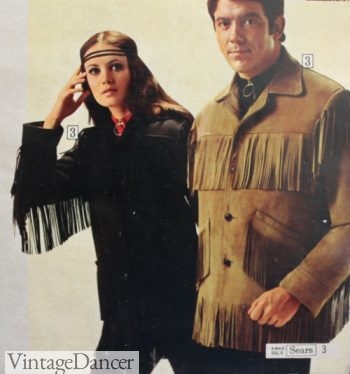
Fringe jackets
Contrarianism. When the Hell’s Angels were the meanest thing to ride the streets in 1964, hippies befriended and associated with them. When a man was arrested in 1968 for wearing an American flag patch, hippies across the nation began wearing the stars and stripes. Antique clothing was very out of style and could be found cheap, so it was worn often. Whatever the populace rejected, the hippies embraced. A surprising amount of savvy went into being the antithesis of society!
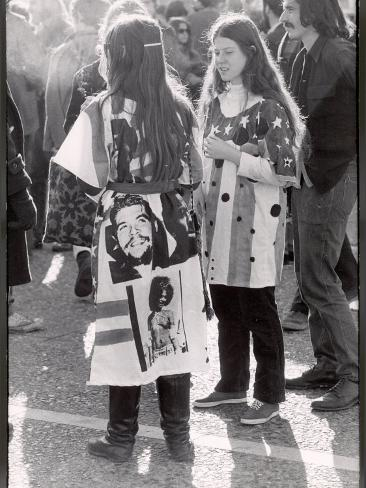
Hippies often chose imagery meant to incite, like these two hippie women wearing dresses with the American flag and Che Guevara in 1968.
Mainstream hippie fashion. By 1970, you could head to your favorite department store and find light blue flare jeans, a groovy paisley shirt, and maybe even a purple bandanna or printed shawl. Hippie-style clothes were the next big thing, and finding certain aspects of it grew much easier when they caught on with designers. In addition to adding some uniformity to the hippie look, it also sanitized hippie fashion into something far less chaotic to appeal to a wider buyer base.
Pictures of 60s Hippies:
- “Flower Power” from across the pond – A British hippie man dressed for a festival in 1967
- Tie dye shirts are an iconic blend of Eastern and psychedelic influence. The shirts are shown here for sale at Woodstock.
- An American flag bandanna, tie dye shirt, tie dye stockings, moccasin boots, “bug-man” aviators, and a cropped vest doesn’t turn heads at Woodstock 1969.
- Joe Crocker performs at Woodstock 1969 in a tie dyed henley shirt and vertical striped pants.
- 1966 hippies adapt mainstream clothing into unique pieces
- (1967) Pattie Boyd embraced the hippie spirituality and its eccentric, Eastern inspired fashion.
- George Harrison and Pattie Boyd-Harrison
- Pattie Boyd and George Harrison in San Francisco
Up next, we will dive into the specifics of Hippie Fashion for women and men.
